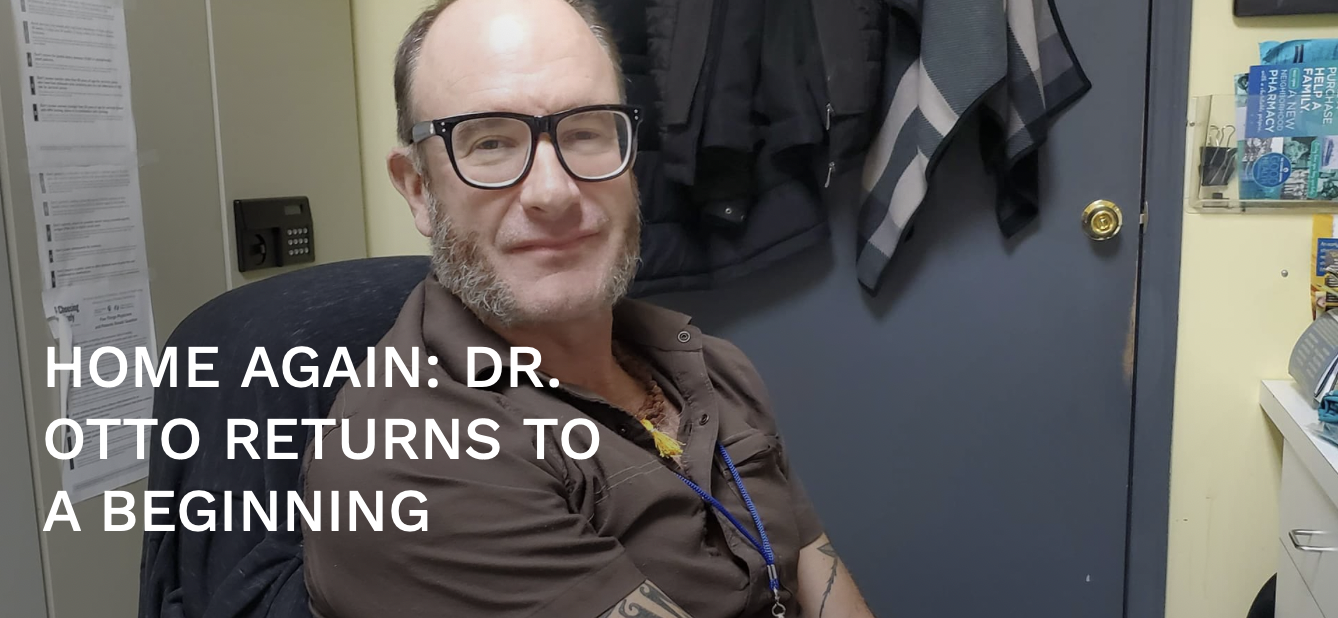
Home Again: Dr. Otto Returns to a Beginning
Dr. Dave Otto helped lead the way for The Floating Hospital on land.
And now this driven Westchester native is back – to serve the community during one of the most challenging healthcare crises the clinic has ever faced.
You joined The Floating Hospital (TFH) at a pivotal time in its history: permanently moving operations from a ship to a fully land-based clinic…
It was exciting. And it was crazy.
My first experience was on the ship (1999). I was in med school at Brown and took an elective with the Department of Community Medicine at St. Vincent’s Hospital in NYC.
As part of that elective, I worked aboard the Lila Acheson Wallace, the fifth and last TFH ship, which docked at the South Street Seaport.

The Lila
When I finished my residency at St. Vincent’s in 2003, I was hired by The Floating Hospital to oversee the Emergency Assistance Unit in The Bronx, where they had a contract to do medical screenings.
In 2005, Sean Granahan became CEO/President of TFH, and he asked me to fill the Medical Director’s role. Sean was brought aboard to pull the organization out of a bind. They were losing staff and money and needed stability while they embarked on a recovery plan.
With Sean and Stiles Nyerere (TFH’s CFO), we were successful in turning things around.
During my tenure, we opened the Long Island City headquarters, which was dedicated to serving NYC’s homeless family population. We added a community health center that served everyone.
We also won a contract to provide medical and dental services for The Department of Juvenile Justice (now called Administration for Child Services).
In 2010, the year I left, we secured a satellite site in Queensbridge Houses (the largest public housing complex in North America) where we could serve that very large community.
What attracted you to the work of The Floating Hospital?
When I went into medicine, I went in with the idea that I wanted to help the underserved.
I didn’t know what that was going to look like. I didn’t know that I was specifically going to be working with the NYC homeless family population. When I finished my residency, and was presented with the opportunity (to work at TFH), I thought, “Ah that’s it. I’ll give it a try. And I fell in love with it.”
These are people who have experienced significant trauma in their lives. A lot of it is physical, sexual, and emotional abuse that they suffered in childhood, often inflicted by their caregivers.
Homelessness includes doubling-up – couchsurfing, which is common in public housing. People share what little space they have because they don’t want their friends or family out on the streets or in the shelter system.
Many times, living conditions are substandard, which causes health problems. Homelessness isn’t just the person on the street.
(Editors note: In NYC, families living in homeless shelters and other unstable housing currently represent 70% of the homeless population)

Ilhabela
You loved the work, yet you left in 2010 to travel the world.
I did. And opened a cafe in Brazil.
While I met my ex-wife here in NYC, she’s originally from Brazil. We decided to live near her family there and start our own family.
We went to India initially, traveled some more, and trained as yoga teachers. We learned we were pregnant in India and headed back to Brazil where we planned to open a cafe and yoga studio.
We traveled the whole coastline and settled in Ilhabela (“beautiful Island,” in Portuguese), with its mountains, waterfalls, and gorgeous beaches, only a 15-minute ferry ride from the mainland where my ex-wife’s parents lived.
We had our daughter, Indi, on the island, and we opened a vegetarian cafe/yoga studio there. I’d always fantasized about living on the beach in South America and having my own business, but it really is as they say there, “muito trabalho e poco dinheiro” – a lot of work and no money!
We created a beautiful experience, but we weren’t making any money.
You came back to the States in 2014?
I missed practicing medicine.
I found that I couldn’t practice in Brazil. There is a pathway, but it’s challenging and requires taking licensing exams in Portuguese.
I took a job back in the states, as the Chief Medical Officer for the Colorado Coalition for the Homeless. After four years there, I took a position at a health center serving the San Francisco homeless population.
I think there is a real place for Western medicine, but I also think there’s a lot of alternative practices that are important, that are missed, that could be used to accompany Western medicine.
So, I stepped down from my job in San Francisco and took a course for physicians in acupuncture, with the goal of being able to treat chronic pain and addiction.

I thought that I was going to go back to Brazil. I was going to live on the beach again, and practice acupuncture.
I had second thoughts. My folks are very old and they live in Maine. I knew that they were going to need my help. Then, coronavirus.
Doctors are needed in the U.S., and I have a license in New York. I always loved NYC! I was ready to practice clinical medicine again, and not do administrative work.
This is uncharted territory with COVID-19. The world is upside-down, there’s lots of unknowns. I’m a doctor, that’s what I’m trained for. I can help. I can also check in on my parents.
I had a casual conversation with Dr. Andre. “You guys need docs?” Because these places always do.
I’ll be at the TFH Queensbridge clinic four days a week. Right there, with people who are the most at-risk. That’s the work that I am suited for. That was my plan. I just took a few detours.
Any insights from your journey?
We are all learning a huge lesson during this time of COVID-19: life is now. It’s this moment.
The Dali Lama said that he was baffled that Western people spent their whole lives killing themselves to make money, only to spend it all to take care of their poor health in retirement.
Yoga and meditation are about pulling yourself into the present moment, quieting your mind. Often, in Western medicine, we spend a lot of time chasing disease, and less on preventing it.
The people that we treat here at TFH, for the most part haven’t had the luxury of experimenting with holistic/alternative healing modalities.
There’s a lot of self-medicating in the homeless population and there’s tons of chronic pain because people have led hard lives, they’ve had all kinds of problems and injuries. They are just trying to get by. We need alternatives to easing pain with opioids, or just telling them to “suck it up.”
Parting words?
I’m grateful to be able to help in a time of crisis.
I’m grateful to be back at The Floating Hospital. This place has a beautiful mission. It was my first job out of residency—I grew with it and it has always felt really special to me.
I’m grateful that my daughter is healthy. And I am healthy.
And, I’m grateful to have a skill that the world needs right now.
This interview has been edited for brevity and clarity.
Share This Story, Choose Your Platform!
Categories
Tags
The Floating Hospital provides high-quality healthcare to anyone who needs it regardless of race, ethnicity, religion, gender, immigration or insurance status, or the ability to pay. By providing unrestricted medical care in tandem with health education and social support to vulnerable New York City families, The Floating Hospital aims to ensure those most in need have the ability to thrive, not just survive.


